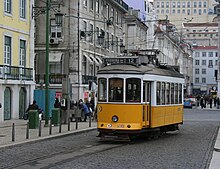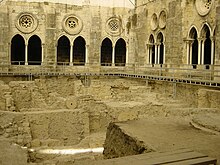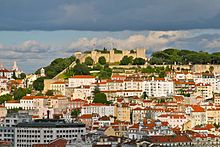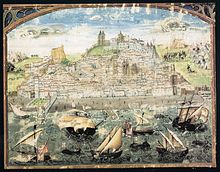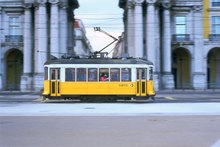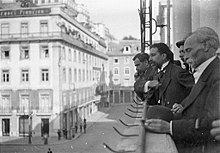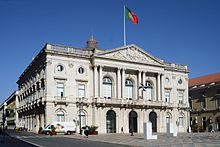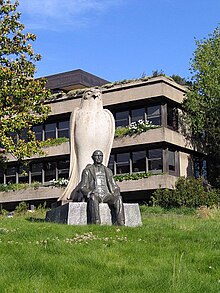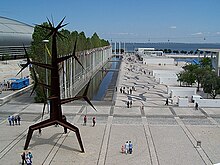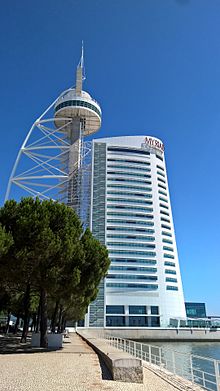Lisbon
Lisbon (pronunciation in Portuguese:/li circleβo//(![]() listen)) is the capital and largest city of Portugal. Located in the mouth of the Tagus River, it is the capital of the country, the capital of the district of Lisbon, the Lisbon region, the Metropolitan Area of Lisbon, and it is also the main centre of the Great Lisbon subregion. The city has a population of 547 773 and its metropolitan area is 2 810 923 on an area of 2921.90 km2. This area contains 26 % of the country's population. Lisbon is the richest city in Portugal.
listen)) is the capital and largest city of Portugal. Located in the mouth of the Tagus River, it is the capital of the country, the capital of the district of Lisbon, the Lisbon region, the Metropolitan Area of Lisbon, and it is also the main centre of the Great Lisbon subregion. The city has a population of 547 773 and its metropolitan area is 2 810 923 on an area of 2921.90 km2. This area contains 26 % of the country's population. Lisbon is the richest city in Portugal.
The municipality of Lisbon, which coincides with the city proper (excluding the larger continuous urban agglomeration that surrounds it), has an extension of 100.05 km², in which in 2011 lived 547,733 inhabitants. Its demographic density is 5,474.59 inhabitants/km². The municipality is subdivided into 24 freguesias (parishes) and is bordered to the north by the municipalities of Odivelas and Loures, to the west by Oeiras, to the northwest by Amadora, and to the southeast by the Tagus estuary. Through the estuary, Lisbon joins the municipalities of the South Bank: Almada, Seixal, Barreiro, Moita, Montijo and Alcochete.
Toponymy
The primitive settlement, Iberian and influenced by trade with Carthage, was called Olissipo. According to Bochart, the name would come from the Phoenicians and would be a derivative of the expression Allis ubbo or safe port in Phoenician or Punic, because it was a magnificent port on the Tagus River estuary, however there is no record that can corroborate this hypothesis. According to Tovar, Olisipo would be of Tartessian origin, since the suffix ipo is common in regions of Turdetan-Tartesian influence. The prefix "Oli(s)" would not be unique as it appears in another Lusitanian city, whose location is currently unknown, which Pomponio Mela called "Olitingi".
Classical authors attributed the foundation and the name to Ulysses or Odysseus, based on the statement of Strabo (Geography, II, 2, 13): "... in Iberia it can also be seen a city called Odysseia.
In the iv century, Solino wrote in About the wonders of the world, XXIII, 2: «Ibi oppidum Olisipone Ulixi conditum: ibi Tagus flumen» («Here the fortress of Olisipo was founded by Ulysses next to the Tagus river»). Luís de Camões, the Portuguese national poet collected the legend in Os Lusíadas (Canto Octavo, V):
It's Ulysses who washes holy house.
To the Numen who gives him fertile tongue
That if in Asia the great Troy opens.
In Europe to Lisbon insigne case.
Olissipo looks like Oilosipon in Ptolemy and was called Ulishbon by the Visigoths and لشبونة (al-Ushbuna) or اليكسبونا (al-Lixbûnâ) by the Muslim conquerors who seized it in 719.
Geography
Lisbon is located at latitude 38°43' north and longitude 9°8' west, making it the westernmost capital in continental Europe. It is located in the west of Portugal, on the coast of the Atlantic Ocean, on the right bank (north) of the Tagus estuary. The city occupies an area of 84.8 km². The limits of the city, contrary to what usually happens in large cities, are well delimited within the limits of the historical perimeter. This produced the creation of several cities around Lisbon, such as Loures, Odivelas, Amadora and Oeiras, which are de facto part of Lisbon's metropolitan perimeter.
The historic center of the city is made up of seven hills, some of the streets being too steep to allow the passage of vehicles; the city is served by three funiculars and an elevator (elevador de Santa Justa). The western part of the city is occupied by the Monsanto forest park, one of the largest urban parks in Europe with an area of almost 10 km².
Centuries ago the estuary was wider; its reduction over the years has caused the expansion of the land available for the city.
Lisbon sits on the remains of an ancient volcanic field that stretches across the entire Lisbon district. Among the best known volcanoes are Monsanto and the Lisbon hills.
| Northwest: Northwest: Odivelas | North: North: Loures | Northeast: Northeast: Vila Franca de Xira and Samora Correia |
| West: West: Amadora |  | This: This: Alcochete |
| Southwest: Southwest: Oeiras | South: South: Almada and Seixal | Sureste: Sureste: Montijo Barreiro |
Transportation
Lisbon is connected to the other bank of the Tagus by two bridges: the 25 de Abril bridge, in the southern part, inaugurated on August 6, 1966, which joins it with the town of Almada, and the Vasco da Range inaugurated in May 1998, connecting the northeast of the capital (Sacavém) to the city of Montijo. Lisbon communicates with the outside world through the Portela airport, the largest in Portugal located 7 kilometers from the center in the northeast area of the city. Currently, the construction of another airport on the south bank of the Tagus River is underway, in Alcochete. The port of Lisbon is a stop for numerous cruise ships and one of the main European tourist ports.
The city hosted, in 1998, the world exhibition (Expo 98), subordinated to the theme of the oceans. The exhibition opened on May 22, 1998, precisely the day that celebrated the 500th anniversary of the discovery of the sea route to India by Vasco da Gama.
The city has an urban and suburban railway network with 8 lines (4 being metro and 4 suburban train) and 118 stations (48 metropolitan and 70 suburban train). The main train stations are the Estación de Oriente, a project by the architect Santiago Calatrava, Cais do Sodré and Santa Apolónia. The operation of the buses is in charge of the company Carris.
Lisbon also maintains 5 tram lines, testimony to a network that was much broader. Four of these are operated with vehicles with an old look, but remodeled, which constitutes a tourist attraction. Line 15 (which links La Plaza de Figueira with Algés) uses modern multi-car trains with low floors.
There is still a river transport network, the Transtejo, which links both banks of the Tagus, with stations in Cais do Sodré, Belém, Praça do Comercio and Parque de las Naciones, on the north bank, and Cacilhas, Barreiro, Montijo, Trafaria, Porto Brandão and Seixal, on the southern bank.
Lisbon and its metropolitan area are connected by several highways. There are two circular highways, the inner and the outer. The main roads that connect the city with the rest of the country are the A1 motorways (to the north via Vila Franca de Xira), the A8 (to the north via Loures), the A5 (to the west via Cascais), the A2 (to the south via Almada and the A12 (to the east via Montijo).
Climate
Lisbon's climate is typical Mediterranean (Csa type), with variable rainfall, dry and very hot summers and mild winters, it is highly influenced by the Gulf Stream, so temperatures are milder and abundant rains. The spring and summer months are generally sunny, with maximum temperatures around 28 °C during July and August, and minimum temperatures around 16 °C. Autumn and winter are generally rainy and windy, with some sunny days. The temperature rarely drops below 5 °C, which normally remains at an average of 10 °C. On average, there are 2,800 hours of sunshine per year and 100 rainy days.
| Month | Ene. | Feb. | Mar. | Open up. | May. | Jun. | Jul. | Ago. | Sep. | Oct. | Nov. | Dec. | Annual |
|---|---|---|---|---|---|---|---|---|---|---|---|---|---|
| Temp. max. abs. (°C) | 22.3 | 23.2 | 28.0 | 28.9 | 36.1 | 39.7 | 41.3 | 43.1 | 37.9 | 34.2 | 28.3 | 24.8 | 40.6 |
| Average temperature (°C) | 13.5 | 14.8 | 16.8 | 17.7 | 19.4 | 25.8 | 26.0 | 27.7 | 27.7 | 24.4 | 16.8 | 14.4 | 20.4 |
| Average temperature (°C) | 9.3 | 10.4 | 11.9 | 13.2 | 16.7 | 20.3 | 22.2 | 23.5 | 18.9 | 16.1 | 12.6 | 10.6 | 17.4 |
| Temp. medium (°C) | 5.0 | 5.9 | 7.1 | 8.6 | 11.0 | 13.8 | 15.5 | 15.2 | 14.1 | 11.5 | 8.3 | 6.8 | 10.2 |
| Temp. min. abs. (°C) | -3.3 | -2.8 | -1.3 | 0.1 | 2.6 | 5.6 | 9.5 | 8.0 | 5.5 | 1.4 | -0.3 | -1.2 | -3.3 |
| Total precipitation (mm) | 99.9 | 84.9 | 53.2 | 68.1 | 53.6 | 15.9 | 4.2 | 6.2 | 32.9 | 100.8 | 127.6 | 126.7 | 774 |
| Precipitation days (≥ 1 mm) | 17 | 16 | 15 | 14 | 13 | 9 | 6 | 5 | 8 | 14 | 15 | 15 | 147 |
| Hours of sun | 124.0 | 130.0 | 192.2 | 216.0 | 257.3 | 273.0 | 306.9 | 294.5 | 225.0 | 182.9 | 138.0 | 124.0 | 2461 |
| Source: Institute of Meteorology (1981-2010), Hong Kong Observatory (Days of rain, Hours of sun, 1961-1990) | |||||||||||||
History
Prehistory
During the Neolithic, the region was inhabited by the substratum of the pre-Indo-European population that has come to be called pre-Iberian. As in other parts of Atlantic Europe, religious monuments called megaliths, dolmens and menhirs were built and can still be seen around the city. Celtic peoples came into contact with the previous substratum and settled in the area before the 1st millennium BC, with the emergence of Celtic-speaking tribes such as the Conii and Cempsii.
The pre-Roman settlement of Olisipo dates back to the viii-vii centuries BC. C and settled on the top and on the slopes of the hill where the castle of San Jorge is currently located. It is estimated that the population was between 2,500 and 5,000 inhabitants.
Ancient Age
Lisbon is for some of Greek origin, for others Phoenician, being a question based more on legend than on archaeological evidence. The natural port created by the Tagus River estuary made it an appropriate point to create a settlement that provided food to the Phoenician ships that were on the trade route to the Tin Islands (now Scilly and Cornwall).
The Phoenicians also took advantage of the location of the colony at the mouth of the largest river in the Iberian Peninsula to trade with the tribes in the interior from which they obtained precious metals. Another important local product was salt, salted fish, and Lusitano horses.
Recently, Phoenician remains from the VIII century B.C. have been found. C. under the Lisbon cathedral. However, some modern historians consider the idea of the Phoenician foundation unrealistic and consider that Lisbon was an ancient autochthonous civilization (oppidum) and that, at most, it maintained commercial relations with the Phoenicians, which would explain the presence of Phoenician pottery and other objects.
During the Punic Wars, after the death of Hannibal Barca (whose troops included members of the Conii tribe), the Romans decided to wrest from Carthage its most valuable possession, Hispania (the name given by the Romans to the peninsula Iberian). After the defeat of the Carthaginians at the hands of Scipio the African in eastern Spain, the pacification of the west was carried out by the consul Décimo Junio Bruto Galaico. He signed an agreement with Olissipo for her to send her subjects to fight alongside the Roman legions against the Celtic tribes to the northwest. As compensation, Olissipo was integrated into the empire under the name of Felicitas Julia, constituting a Municipium Cives Romanorum. Self-government was guaranteed in a territory of 50 kilometers around the city, they were exempt from taxes and their citizens had the privileges of Roman citizens.[citation needed] The area it went on to constitute the province of Lusitania with its capital in Emerita Augusta. Lusitanian attacks on the city during frequent rebellions weakened the city and a wall had to be built.
During the reign of Caesar Augustus, the Romans built a theater and amphitheatre; some hot springs located in the current Calle de la Plata; The temples of Jupiter, Diana, Cybele, Thetis and Idae Phrygiae (a rare cult from Asia Minor), apart from temples in honor of the emperor; a necropolis under the current Figueira square; a forum and other buildings such as the insulae, a housing area between the present castle hill and the city center. Many of these ruins were unearthed in the mid-century xviii, when the discovery of Pompeii unleashed a wave of archaeological furor in the European upper classes.
Economically, Olissipo was known for its garum, a kind of aphrodisiac fish sauce that was exported to Rome and other cities. Wine, salt and horses were other export items. In addition to the exploitation of gold and silver mines, a large part of the wealth that the Romans obtained came from tributes, taxes, ransoms and looting of the treasures of the peoples of Lusitania and the rest of the peninsula. The city prospered as piracy ended and technological advances arrived, allowing for the expansion of trade with the new Roman provinces of Britain (especially Cornwall and the Rhine and through the civilization that lived on the banks of the Tagus. The city was ruled by an oligarchy dominated by two families, the Julii and the Cassiae.
Along with the majority of Latin speakers were minorities of Greek traders and slaves. The city was connected by Roman roads to two other cities, Bracara Augusta in the province of Tarragona (currently the Portuguese city of Braga) and Emerita Augusta, currently Mérida (Spain).
Olissipo would be one of the first nuclei to embrace Christianity. The first bishop of the city was Saint Gens. It suffered the barbarian invasions by the Alans, the Vandals and later it was part of the kingdom of the Suevos, before being taken over by the Visigoths of the Visigothic kingdom of Toledo, who called it Ulishbona.
Middle Ages
Lisbon was taken by the Arabs in about 711 (it received the name “al-ʾIšbūnah” in Arabic الأشبونة). Muslims, coming from North Africa and the Near East, built several mosques, houses and the walls of the city, which is now called Cerca Moura. The city supported a diverse population including Christians, Berbers, Arabs, Jews and Saqalibas.
Arabic became the official language. Mozarabic was the mother tongue spoken by the Christian population. Islam was the official religion, practiced by the Arabs and the muladís, Christians and Jews could maintain their beliefs, as dhimmis, and upon payment of the jizia. The Muslim influence can still be seen in the Alfama, the old part of the city that resisted the earthquake. Some names derive from Arabic; Alfama, the oldest district of Lisbon, derives from the Arabic al-hamma.
It was sacked in 798 by Alfonso II of Asturias. In 844, the Vikings attack Lisbon with 54 ships and sacked it for thirteen days before being driven out. There was another Viking invasion in 966. Between 1013 and 1022, during the Taifa period, Lisbon belonged to the Taifa of Badajoz, while it remained under the power of Sabur al-Saqlabi, a Saqaliba, a former subject of Alhakén II.
A first attempt by the Portuguese to take the city failed in 1137. In 1147, as part of the Reconquista, a group of French, English, German, and Portuguese knights, led by Alfonso I of Portugal, besieged and conquered Lisbon passing into Christian hands.
The reconquest of Portugal and the reestablishment of Christianity is one of the most significant events in Lisbon's history; although it is known that there was a Mozarabic bishop in the city who was assassinated by the crusaders and that the population was praying to the Virgin when a plague attacked them. Arabic lost its official status and little by little it was stopped being used in daily life. The Muslim population that remained converted to Catholicism or were expelled, while the mosques were transformed into churches.
Lisbon received its first charter in 1179 and became the capital of Portugal in 1255 due to its central location in Portuguese territory.
Between 1383 and 1385 there was a civil war (crisis of 1383-1385) in Portugal over the succession of the last king of the Burgundian dynasty, Ferdinand I, between supporters of Dona Beatriz de Portugal, the wife of King John I of Castile and those of Juan I de Avis. Lisbon, aligned with the Avis side, suffered a siege by the Castilian army (which intervened in the crisis in favor of Beatriz), raised by a plague epidemic among the besiegers. A second land invasion was defeated at Aljubarrota in 1385.
In 1290, Dionysius I founded the Estudo Geral (General Study) (currently the University of Coimbra), being transferred several times to Coimbra, where he settled permanently in the xvi.
Modern Age
Most of the Portuguese Age of Discovery expeditions left Lisbon during the 15th and 17th century, including Vasco da Gama's departure for India in 1497. The 16th century marks the golden age of Lisbon that became a point of European trade with the Far East, while gold from Brazil arrived in the city.
In this golden age, houses in Lisbon had between three and five floors, the ground floor being a shop and the last warehouses for merchants. At this time Lisbon picks up the witness of the Genoese in the slave trade (who were from Africa, the Iberian Peninsula and the rest of Europe). It became a port through which slaves passed that were later sold in various parts of Europe. Lisbon received a large number of foreign merchants.
After the incorporation of Portugal into the Spanish Monarchy of Felipe II (1580), the establishment of the court in Lisbon was even considered, but it was discarded, in favor of Madrid, where the capital had been established in 1561. The main episodes of the restoration revolt of 1640, which gained independence from Portugal, took place in Lisbon.
At the beginning of the 18th century, during the reign of John V, the city was endowed with a large, extraordinary public work for the time: the aqueduct of the Free Waters.
The 1755 Lisbon earthquake killed between 60,000 and 100,000 people. Voltaire wrote his Poême sur le désastre de Lisbonne, just afterward, and mentioned the earthquake in his novel Candide of 1759 (in fact, some argue that his critique of optimism was inspired by the earthquake). Oliver Wendell Holmes also mentions him in his 1857 poem The Deacon's Masterpiece, or The Wonderful One-Hoss Shay.
After the 1755 earthquake, the city was rebuilt according to the plans of the Marquis of Pombal, for which the central part is called Baixa Pombalina. Instead of rebuilding the medieval city, the Marquis de Pombal decided to destroy what had resisted the earthquake and rebuild the city with urban regulations of the time. The grid adopted in the reconstruction plans made it possible to design Rossio and Comercio squares.
Contemporary Age
At the beginning of the 19th century, Portugal was invaded by the troops of Napoleon Bonaparte, forcing King John VI to flee to Brazil. Napoleonic forces were driven out by Anglo-Portuguese armies under Arthur Wellesley, Duke of Wellington. This allowed the occupants to evacuate the city, agreed in the Sintra Agreement.
The city lived through the Civil War intensely and the era of the flourishing of cafeterias and theaters began. Later, in 1879, the Avenida da Liberdade was opened, which began the expansion of the city beyond the Baixa.
Lisbon was the center of the Revolution of October 5, 1910, which established the First Portuguese Republic. Previously, the regicide of Carlos I had taken place in 1908.
During World War II, Lisbon was one of the few neutral European Atlantic ports, being a gateway for refugees.
In Lisbon, the Carnation Revolution took place, which in 1974 put an end to the dictatorial regime that had been in power since 1928.
In 1985, the Treaty of Accession to the European Economic Community of Portugal and Spain was signed, in the Jerónimos Monastery, in Lisbon, by the President of the Republic, Mário Soares.
In 1988, the Chiado fire killed two people and caused 75 serious injuries. Nearly twenty historic buildings and an area of 10,000 m² were destroyed in this fire whose extinguishing tasks were not given by finished up to 11 days after its start. The event interrupted the normal life of the area for ten years.
Lisbon was the European Capital of Culture in 1994. Expo 98 was held to coincide with the commemoration of the 500th anniversary of Vasco da Gama's trip to India. This event was used to carry out a remodeling in the city.
The Lisbon Agenda was an agreement of the European Union based on measures to improve the European economy, signed in Lisbon in 1999. However, the most far-reaching event that the EU has held in this city is the signing of the Treaty of Lisbon in December 2007.
Demographics
The city's population is characterized by its ups and downs throughout its history. It overcame Seville after the plague in the 17th century and up to a good part of the 19th century was the most populous city on the peninsula. Currently, the population of Lisbon is declining and has been surpassed by Madrid, Barcelona, Valencia, Seville, Zaragoza and Malaga. The population of the metropolitan area is increasing because the population is moving from the center to the periphery or even to other neighboring cities.
The population of the city is 564,477 according to the 2001 census, the metropolitan area has 2,641,006 inhabitants in an area of nearly 3,000 km², about a third of the population of Portugal. The population density of the city is 6518.1 inhabitants per km². The Lisbon metropolitan area is one of the fastest growing urban agglomerations in the European Union, with its population estimated to increase to 4.5 million by 2050.
In the current demographic structure of Lisbon, women represent more than half of the population (54%) and men 46%. The city has an aging demographic pyramid with 23% of people aged 65 or older. more, while the Portuguese average is 16%. 13% of the population is under 15 years old, 9% is between 15 and 24 and the remaining 53% is between 25 and 64.
As a curiosity, it should be added that the people of Lisbon are nicknamed alfacinhas, due to the intensive cultivation of lettuce that the ancient inhabitants of Lisbon did in the fields near the capital.
Administration and politics
Lisbon is home to the main political centers of the country (ministries, courts, etc.). The municipality of Lisbon is administered by the city council made up of 17 councillors. There is a municipal assembly that is the legislative body of the municipality, made up of 107 deputies. The mayor is Fernando Medina (PS).
Two European Union agencies are based in Lisbon; the European Observatory for Drugs and Drug Addiction, and the European Maritime Safety Agency. The CPLP (Community of Portuguese Language Countries) is also based in Lisbon.
Territorial organization
Economy
Lisbon is the richest city in Portugal with a GDP per capita higher than the European average. The port of Lisbon competes with that of Bilbao as the main container port of the "European Atlantic Arc". It is equipped with three docks for various cruise ships: Alcântara, Rocha Conde Obidos and Santa Apolónia. On the other hand, the city has several marinas, such as in Belém, Santo Amaro, Bom Sucesso, Alcântara and Olivais.
Lisbon, as the capital of Portugal, has an economy concentrated in services. Most of the headquarters of the existing multinationals in the country are located in Lisbon and it is also the 9th city in the world that holds the most congresses.
The metropolitan area of Lisbon is highly industrialized, especially in the following sectors: oil refining, textile industry, shipyards, steel industry and fishing.
Education
Lisbon refounded its own university in 1911 after centuries of inactivity, bringing together various pre-existing schools and colleges such as the Polytechnic School.
In this city there are three public universities; the University of Lisbon, the Technical University of Lisbon and the New University of Lisbon. Among the private establishments, the Portuguese Catholic University and the ISCTE stand out.
Despite the many educational institutions, Lisbon does not have any university that is included in the top hundred worldwide.
Culture
Lisbon is one of the great European cultural centers. Older than Rome, epicenter of discoveries and capital of the empire since the xv century, the city has preserved cultural relations with the former Portuguese colonies, being meeting point of various cultures, the first place where the East, the Indies, Africa and America met.
The Alfama-Baixa/Chiado-Bairro Alto axis is a stage for scholarly culture and for popular, young and traditional culture. On any Lisbon night, even during the week, the offer is varied.
Lisboans are often referred to as "alfacinhas" (literally "lechuguitas"). That term comes from primitive Lisbon that was famous for growing lettuce. The word alface in Portuguese comes from Arabic and could indicate that the cultivation of the plant began with the Arab domination. There are also historians who think that, during a siege of the city, lettuce was the only food they could eat since it was the only thing they had left. The truth is that this word became established and the greats of Portuguese literature used to call the people of Lisbon "alfacinhas".
Events
Since 1994 when it was the European Capital of Culture, Lisbon has hosted several international events such as Expo '98 and Euro 2004, which have had a great impact on the development of cultural activities and infrastructures. In 2005 Lisbon was considered by the International Congress & Convention Association as the eighth most sought-after city in the world for holding international events and congresses. Several initiatives have passed through Lisbon such as the Gymnaestrada, the MTV Europe Music Awards and the Dakar Rally or the fifty years of the Tall Ships' Races (international tall ship regatta).
Carnival is celebrated in schools and by children, in recreational institutions and in the Barrio Alto. With the beginning of spring, mass events take place such as Indie Lisboa, an international alternative film festival and the Lisbon Book Fair, which takes place outdoors in Eduardo VII Park.
During the month of June, popular festivals take place in typical neighborhoods such as Alfama, Madragoa, Mouraria, Castelo and others, which are decorated with flower arches. Neighbors and associations improvise stalls where grilled sardines, traditional sweets, wine and sangria are sold. The night of San Antonio, the eve of June 13, is the peak of the festivities. Thousands of people crowd the streets and make this the biggest party in Portugal, even bigger than the New Year's Eve celebration. At the beginning of the night, traditional groups parade on Avenida da Liberdade, in a competition in which each neighborhood fights to win the prize for best choreography.
In the summer, there are theater and performing arts festivals, such as the Almada festival and the Alkantara Festival/Danças na Cidade) as well as music festivals such as Super Bock Super Rock, Optimus Alive! and Rock in Rio, which takes place every two years. In August, when the city is deserted for the holidays, the culture continues with the Jazz Festival organized by the Calouste Gulbenkian Foundation and with the festival of the oceans that takes place in the Parque de las Naciones.
In September, there is a Design Biennial and the Lisbon International Organ Festival, as well as the Lisbon Half Marathon, in which tens of thousands of Lisbonians run over the Vasco de Gama Bridge. In autumn, the Doc Lisboa festival and the Lisbon Gay and Lesbian Film Festival take place.
ModaLisboa is held in winter with the Lisbonarte (visual arts exhibitions in art galleries) and the Mostra de Teatro Jovem (youth theater exhibition).
In Greater Lisbon there are cultural events, such as the festival of the Portuguese Communist Party in the city of Amora, the Sintra music festival, the Almada festival (a theater festival that is also held in some theaters in downtown Lisbon), the Amadora International Comic Festival or the Seixal Jazz Festival. In May 2018, Lisbon hosted the Eurovision Song Contest after Salvador Sobral's victory at the same festival in 2017 with the theme "Amar pelos dois".
Architecture and urbanism
Outstanding elements of medieval architecture in Lisbon are the castle of São Jorge, on the highest hill in the center of the city; the Alfama neighborhood that survived the Lisbon earthquake; the Lisbon Cathedral and the Carmo Convent.
From the city of the Age of Discovery, two buildings classified by Unesco as World Heritage Sites can be seen in the Belém area: the Manueline-style Jerónimos Monastery and the Belém Tower, a military construction that guarded the entrance to the Tagus. Before it was in the center of the river but now it is to one side.
The Baixa is the heart of the city. It stands on the ruins of the ancient city that was destroyed by the 1755 Lisbon earthquake. Its urban planning, grid streets and similar buildings are due to the Marquis of Pombal. The Baixa is also Lisbon's largest commercial district. In it are the majority of monuments, such as the Doña María II National Theater, the Plaza del Comercio and the Rossio.
The Barrio Alto[citation required] (commercial, entertainment and residential district) and the Barrio de la Alfama, with narrow streets, also form part of the historic core. (unlike Bairro Alto, it is a quieter area). In this neighborhood is the Cathedral as well as the Castle of São Jorge and the Casa dos Bicos, current headquarters of the José Saramago Foundation. Finally, on the banks of the Tagus, the Belém neighborhood is located. There is the Jerónimos Monastery, whose construction began in 1501 and took seventy years to complete. It is the best example of what has been called the Manueline style, whose inspiration comes from the territories visited during the Age of Discoveries, and is also influenced by the Gothic and Renaissance styles. Near the monastery is the Torre de Belém.
Dating from the early 18th century century, the most significant monument is the Aguas Libres Aqueduct. After the earthquake, the urban plan approved by the Marquis of Pombal created the Comercio and Rossio squares. Nearby is the Plaza de los Restauradores and the Elevador de Santa Justa, designed at the end of the 19th century by Mesnier du Ponsard. The Doña María II National Theater is the main theater in the city.
At the end of the xix century, urban plans allowed the city to be extended beyond the Baixa, creating the current Avenida da Liberdade. In 1934 the Marqués de Pombal square was built at the end of the avenue. In the 20th century the Avenidas Novas and the University City of Lisbon were created.
The reconstruction of Chiado since 1988, under the direction of Álvaro Siza, involved a vast work in the historic center. In terms of architecture, the most notable of the late xx century is the Parque de las Naciones and Alta de Lisboa, still under construction. The most famous buildings from the late xx century are the Centro Cultural de Belém (inaugurated in 1991), the Pavilhão de Portugal (by Álvaro Siza Vieira), the Oriente Station (by Santiago Calatrava), the Vasco da Gama Tower and the Lisbon Oceanarium (by Peter Chermayeff), all from 1998.
Real estate speculation has devastated, in recent years, buildings of old architectural style, but not classified on the list of the Portuguese Institute of Architectural Heritage, to satisfy the growing search for new flats. The development of the Lisbon economy brought with it an explosion of marketing and, consequently, of patronage. Large theaters, museums and other institutions now display the logos of national and multinational companies.
In the western part of the city is the Palácio Nacional da Ajuda in the freguesia of Ajuda. Also noteworthy are the Palace of Needs, current headquarters of the Portuguese Ministry of Foreign Affairs, and the Belém Palace in the freguesia of Belém, which is the official residence of the President of Portugal. Other major architectural works are the National Library, and museums such as the National Museum of Ancient Art, the Calouste Gulbenkian Museum, the Chiado Museum, the Pharmacy Museum and the Lisbon Oceanarium. In the performance halls, the Lisbon Coliseum, the Aula Magna, the auditoriums of the Calouste Gulbenkian Foundation and the Belém Cultural Center and the Atlantic Pavilion stand out.
Music
The traditional music of Lisbon is fado, a nostalgic song accompanied by a Portuguese guitar. Most of the fado venues are located in the Alfama, being generally restaurants with live music. Lisbon, as the capital of Portugal, is the musical center of the country, where most of the records by Portuguese singers are produced.
On July 25, 2017, Lisbon was designated by RTP (the country's public television) as the venue for the 2018 Eurovision Song Contest, following the victory of the Portuguese country in the 2017 contest with the song &# 34;Amar pelos dois", interpreted by Salvador Sobral.
Cinema
Every year the following festivals take place:
- International Documentary Film Festival - DocLisboa
- International Independent Film Festival - Indie Lisbon
- International Terror Film Festival - MoteLX
Gastronomy
Lisbon's gastronomy is influenced by its proximity to the sea. Typical Lisbon specialties are grilled sardines, cod pataniscas and peixinhos da horta (which are fried green bean balls, not fish). It is said that the Portuguese, and especially the people of Lisbon, have 365 ways of preparing cod, a different recipe for each day of the year. Steaks such as Bife à Marrare were popular in some social gathering cafes during the Bohemian era.
The most famous dessert in Lisbon is the Pastel de Belém, made in the oldest factory, which is located in the freguesia of Belém.
Sports
The sports clubs Sporting Clube de Portugal and Sport Lisboa e Benfica play in different sports modalities of the highest categories of the Portuguese and European competitions. Atlético CP and OS Belenenses are other important sports clubs with a great tradition in Portuguese sport, also having their headquarters in the capital. Both compete in the current Primeira Liga where Sporting CP is partially first and also SL Benfica.
Soccer is the most popular sport in Lisbon. The most important soccer clubs are Benfica, whose stadium is the Estádio da Luz, with five UEFA stars, and which has 65,000 seats. Benfica has won the UEFA Champions League twice. For their part, Sporting Lisbon also play in a 5-star stadium. They have won the European Cup Winners' Cup once and have been UEFA Cup finalists. They play at the José Alvalade Stadium with a capacity for 52,000 people. The colors of the stadium are green and white. There are also the Belenenses, playing at the Estádio do Restelo in the freguesia of Belém, who won the Portuguese First League 1 time and the Portuguese Cup another 3 times. The other great club with a lot of history is Atlético Clube de Portugal, playing at the Tapadinha stadium, in the freguesia of Alcântara (Lisbon).
Futsal is probably the second most popular sport in Lisbon, with four teams in the first league. The three big sports teams, Belenenses, Benfica and Sporting have professional teams while S.L. Olivais is an amateur team.
Lisbon hosted the 2003 World Men's Handball Championship, which was held at the Pavilhão Atlântico. Los Belenenses, Benfica and Sporting have professional teams, playing in the first division. Professional Basketball has followers in Lisbon with Benfica and Belenenses as teams representing the city.
Another popular sport is hockey, which after the victory of the national team has gained a great following in the city, especially among those who support Lisbon's biggest team, Benfica. In March, tens of thousands of participants cross the April 25 Bridge in the Lisbon Half Marathon. In 2006 and 2007, the Dakar Rally started from Belém.
Twin cities
Lisbon is part of the Union of Ibero-American Capital Cities (UCCI) which brings together 27 Ibero-American cities and is also twinned with the following cities:
- Paris,
 France (1998)
France (1998) - São Paulo, Brazil
 Brazil - July 10, 2007.
Brazil - July 10, 2007. - Buenos Aires,
 Argentina Cooperation Convention in 1992
Argentina Cooperation Convention in 1992 - Rio de Janeiro, Brazil
 Brazil - (Cooperation Agreement of 3 September 1993)
Brazil - (Cooperation Agreement of 3 September 1993) - Budapest, Hungary
 Hungary - 28 September 1992.
Hungary - 28 September 1992. - Macao, China
 ChinaMacao
ChinaMacao Macao - May 20, 1982.
Macao - May 20, 1982. - Madrid, Spain
 Spain - May 31, 1979.
Spain - May 31, 1979. - Tegucigalpa, Honduras
 Honduras - July 15, 1977.
Honduras - July 15, 1977. - Salvador de Bahia, Brazil
 Brazil - April 3, 1985
Brazil - April 3, 1985 - Bissau, Guinea-Bissau
 Guinea-Bisáu - 31 May 1983.
Guinea-Bisáu - 31 May 1983. - Brasilia, Brazil
 Brazil - June 28, 1985.
Brazil - June 28, 1985. - Cacheu, Guinea-Bissau
 Guinea-Bissau - 14 November 1988.
Guinea-Bissau - 14 November 1988. - Luanda, Angola
 Angola - 11 October 1988.
Angola - 11 October 1988. - Malaca, Malaysia
 Malaysia - January 19, 1984.
Malaysia - January 19, 1984. - Maputo, Mozambique
 Mozambique - 20 March 1982.
Mozambique - 20 March 1982. - Praia, Cape Verde
 Cape Verde - 26 May 1983.
Cape Verde - 26 May 1983. - Rabat, Morocco
 Morocco - 22 March 1988.
Morocco - 22 March 1988. - Rio de Janeiro, Brazil
 Brazil - June 10, 1980.
Brazil - June 10, 1980. - Sao Tome,
 Sao Tome and Principe - 26 May 1983.
Sao Tome and Principe - 26 May 1983. - Guimarães,
 Portugal - 29 Junho of 1993.
Portugal - 29 Junho of 1993. - Beijing, China
 China - 22 October 2007.
China - 22 October 2007.
Contenido relacionado
Turkmenistan
Belarus
Greater Antilles


